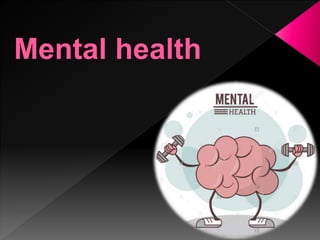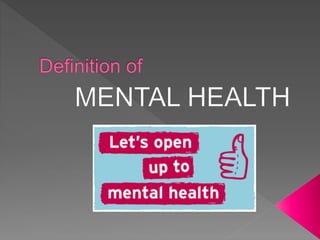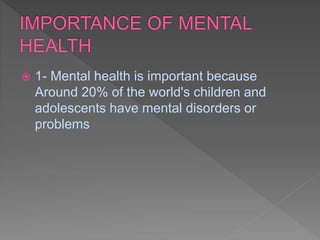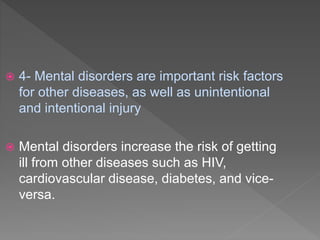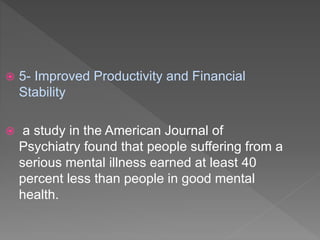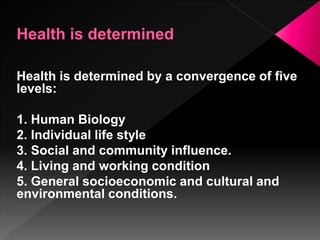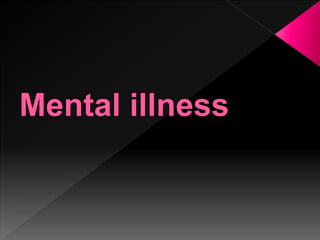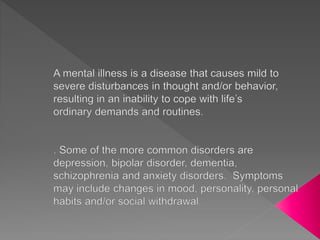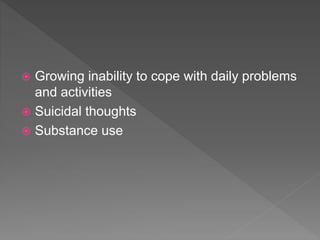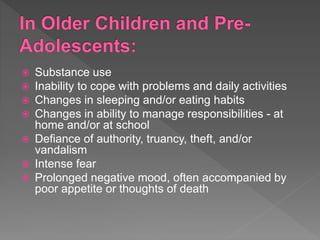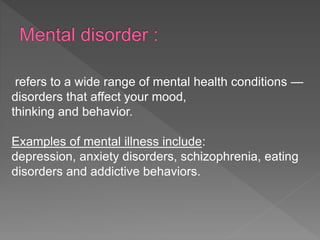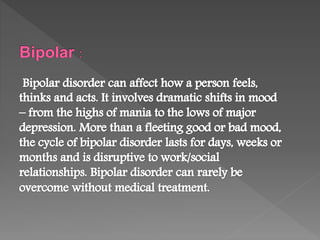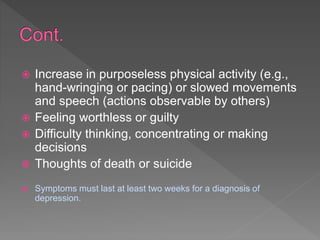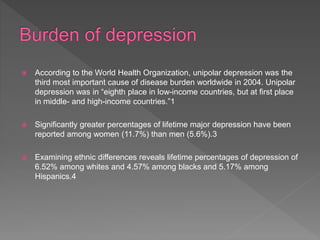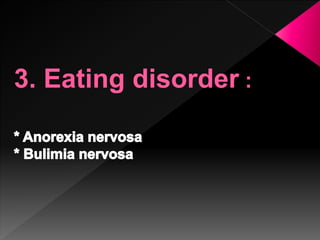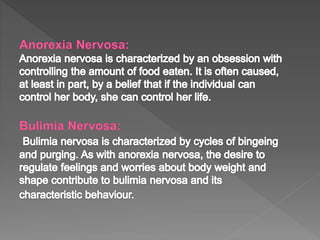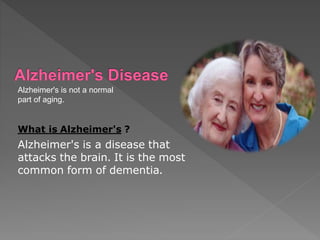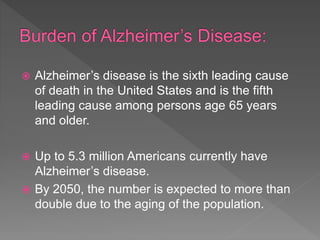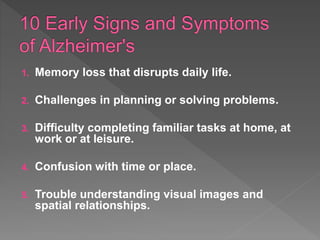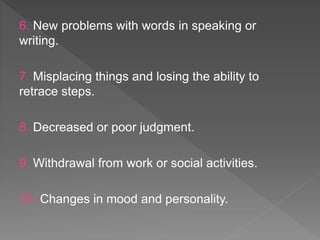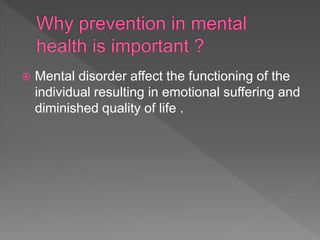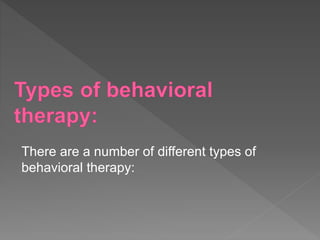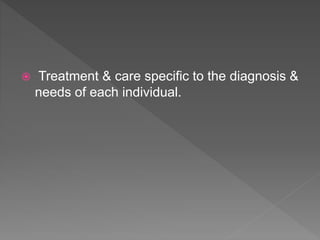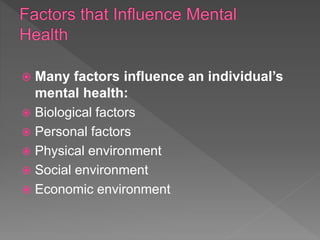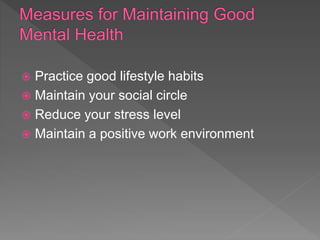Mental health
- 3. Mental health is defined as a state of well- being in which every individual realizes his or her own potential, can cope with the normal stresses of life, can work productively and fruitfully, and is able to make a contribution to her or his community.
- 4. 1- Mental health is important because Around 20% of the world's children and adolescents have mental disorders or problems
- 5. 2- Mental and substance use disorders are the leading cause of disability worldwide About 23% of all years lost because of disability is caused by mental and substance use disorders.
- 6. 3- About 800 000 people commit suicide every year 75% of suicides occur in low- and middle- income countries. Mental disorders and harmful use of alcohol contribute to many suicides around the world.
- 7. 4- Mental disorders are important risk factors for other diseases, as well as unintentional and intentional injury Mental disorders increase the risk of getting ill from other diseases such as HIV, cardiovascular disease, diabetes, and vice- versa.
- 8. There is a strong connection between the mind and body. A 2012 study in Health Services Research confirmed this connection, mental distress impair physical health (for example: sleeping disturbances and impairing immune functions)
- 9. 5- Improved Productivity and Financial Stability a study in the American Journal of Psychiatry found that people suffering from a serious mental illness earned at least 40 percent less than people in good mental health.
- 10. 6- Less Strain on the Family The children of people with mental illness are at greater risk for abuse, neglect, and a wide range of emotional and behavioral issues. .
- 11. Your mental well-being affects your physical health and productivity, so it’s not only a personal matter, it also affect your surrounding society.
- 12. In order to improve population health status and reduce health inequalities, it is important to identify and understand the main factors that protect and promote good health. These factors are known as the determinants of health.
- 13. Health is determined by a convergence of five levels: 1. Human Biology 2. Individual life style 3. Social and community influence. 4. Living and working condition 5. General socioeconomic and cultural and environmental conditions.
- 14. It includes those aspects of health (both mental and physical) which are determined by the organic structure and physiological functioning of the human body.
- 15. Inheritance plays a part in determining lifespan, healthiness and the likelihood of developing certain illnesses. The inheritance factors are can be: Race Sex Inherited Diseases
- 16. Tobacco use Unhealthy diet Inadequate activity Alcohol and drug use
- 17. The social and community factors that have been shown in a variety of settings to have the greatest influence on health are: Education Social cohesion social connectedness.
- 18. Education has profound health effects. More education makes an individual more aware of healthy and unhealthy choices and makes it easier to make healthy choices. A low level of education is associated with poor health status. Low education levels are linked with poor health, more stress and lower self-confidence.
- 19. People with strong family, cultural and community bonds have better health than people who are socially isolated.
- 20. Housing Overcrowding, damp and cold have direct effects on physical and mental health. High housing costs leave less money for other budget items essential to good health including nutritious food, education, and access to health services. work Work can influence health in many ways, including through links both with health care insurance and with physically hazardous exposures in the workplace.
- 21. The main factor determining adequate income is participation in continuous employment .As such, employment is an important determinant of health.In addition to providing income, employment enhances social status and improves self-esteem, provides social contact and a way of participating in community life, and enhances opportunities for regular activity, which all help to enhance individual health and well-being.
- 22. Income Poverty Ethnicity Culture Environment
- 23. Income is the single most important determinant of health. There is a persistent correlation between low income and poor health. the low income leads to the highest rates of illness and death. Adequate income is a prerequisite for many other determinants of health, for example, adequate housing, a nutritious diet and educational opportunities.
- 24. Poverty has long been recognized as an important determinant of ill health. People who are poor have worse self- reported health, higher rates of disability, and higher rates of death, disease and injury.
- 25. The Physical Environment : The quality of air.water safety. Food safety. Drugs and other chemicals products. Waste disposal. control of excessive noise. The radiation.
- 26. Health is determined by a convergence of five levels: 1. Human Biology 2. Individual life style 3. Social and community influence. 4. Living and working condition 5. General socioeconomic and cultural and environmental conditions.
- 29. Mental health problems may be related to excessive stress due to a particular situation or series of events. As with cancer, diabetes and heart disease, mental illnesses are often physical as well as emotional and psychological. Mental illnesses may be caused by a reaction to environmental stresses, genetic factors, biochemical imbalances, or a combination of these. With proper care and treatment many individuals learn to cope or recover from a mental illness or emotional disorder.
- 31. In Adults, Young Adults and Adolscents: Confused thinking Prolonged depression (sadness or irritability) Excessive fears, worries and anxieties Social withdrawal Strong feelings of anger Strange thoughts (delusions) Seeing or hearing things that aren't there (hallucinations)
- 32. Growing inability to cope with daily problems and activities Suicidal thoughts Substance use
- 33. Substance use Inability to cope with problems and daily activities Changes in sleeping and/or eating habits Changes in ability to manage responsibilities - at home and/or at school Defiance of authority, truancy, theft, and/or vandalism Intense fear Prolonged negative mood, often accompanied by poor appetite or thoughts of death
- 34. Changes in school performance Poor grades despite strong efforts Changes in sleeping and/or eating habits Excessive worry or anxiety (i.e. refusing to go to bed or school) Hyperactivity Persistent nightmares Persistent disobedience or aggression
- 35. Fatigue Back pain Chest pain Digestive problems Dry mouth Headache Sweating Weight gain or loss Rapid heart rate Dizziness
- 37. refers to a wide range of mental health conditions — disorders that affect your mood, thinking and behavior. Examples of mental illness include: depression, anxiety disorders, schizophrenia, eating disorders and addictive behaviors.
- 42. Acrophobia
- 43. Trypophobia
- 48. DEPRESSIO N
- 49. Depression causes feelings of sadness and/or a loss of interest in activities once enjoyed. It can lead to a variety of emotional and physical problems and can decrease a person’s ability to function at work and at home.
- 50. Feeling sad or having a depressed mood Loss of interest or pleasure in activities once enjoyed Changes in appetite — weight loss or gain unrelated to dieting Trouble sleeping or sleeping too much Loss of energy or increased fatigue
- 51. Increase in purposeless physical activity (e.g., hand-wringing or pacing) or slowed movements and speech (actions observable by others) Feeling worthless or guilty Difficulty thinking, concentrating or making decisions Thoughts of death or suicide Symptoms must last at least two weeks for a diagnosis of depression.
- 52. According to the World Health Organization, unipolar depression was the third most important cause of disease burden worldwide in 2004. Unipolar depression was in “eighth place in low-income countries, but at first place in middle- and high-income countries.”1 Significantly greater percentages of lifetime major depression have been reported among women (11.7%) than men (5.6%).3 Examining ethnic differences reveals lifetime percentages of depression of 6.52% among whites and 4.57% among blacks and 5.17% among Hispanics.4
- 53. Biochemistry: Differences in certain chemicals in the brain may contribute to symptoms of depression. Genetics: Depression can run in families. For example, if one identical twin has depression, the other has a 70 percent chance of having the illness sometime in life. Personality: People with low self-esteem, who are easily overwhelmed by stress, or who are generally pessimistic appear to be more likely to experience depression.
- 54. Personality: People with low self-esteem, who are easily overwhelmed by stress, or who are generally pessimistic appear to be more likely to experience depression. Environmental factors: Continuous exposure to violence, neglect, abuse or poverty may make some people more vulnerable to depression.
- 55. PSYCOTHERAPY or “talk therapy,” is sometimes used alone for treatment of mild depression; for moderate to severe depression, psychotherapy is often used in along with antidepressant medications. MEDICATIONS (Anti- depressants) . Antidepressants may produce some improvement within the first week or two of use. Full benefits may not be seen for two to three months. .
- 64. Alzheimer's is not a normal part of aging. What is Alzheimer's ? Alzheimer's is a disease that attacks the brain. It is the most common form of dementia.
- 65. Alzheimer’s disease is the sixth leading cause of death in the United States and is the fifth leading cause among persons age 65 years and older. Up to 5.3 million Americans currently have Alzheimer’s disease. By 2050, the number is expected to more than double due to the aging of the population.
- 66. 1. Memory loss that disrupts daily life. 2. Challenges in planning or solving problems. 3. Difficulty completing familiar tasks at home, at work or at leisure. 4. Confusion with time or place. 5. Trouble understanding visual images and spatial relationships.
- 67. 6. New problems with words in speaking or writing. 7. Misplacing things and losing the ability to retrace steps. 8. Decreased or poor judgment. 9. Withdrawal from work or social activities. 10. Changes in mood and personality.
- 68. Alzheimer's disease typically progresses slowly in three general stages: mild (early-stage) moderate (middle-stage) severe (late-stage) Since Alzheimer's affects people in different ways, each person will experience symptoms - or progress through Alzheimer's stages - differently.
- 69. Age. Family history, and heredity. Other risk factor, such as: head injury, and heart-head connection.
- 70. To prevent the occurrence of mental disorder WHO has established department of mental health and substance depends
- 71. Mental disorder affect the functioning of the individual resulting in emotional suffering and diminished quality of life .
- 72. Preventive strategies need to be implemented at a specific periods before the onset of mental disorder , in order to be maximally effective
- 73. _ primary ■ Universal prevention: targeting the general public or a whole population group. ■ Selective prevention: targeting individuals or subgroups of the population whose risk of developing a mental disorder is significantly higher than that of the rest of the population. ■ Indicated prevention: targeting persons at high-risk for mental disorders. _Secondary prevention refers to reduce the prevalence, i.e. all specific treatment.
- 74. WHO defines health promotion as “the process of enabling people to increase control over, and to improve their health” Strategies for mental health promotion are related to improving the quality of life and potential for health rather than amelioration of symptoms and deficits.
- 75. Enhancement of the capacity of individuals , family , groups or communities to strengthen or support positive emotional
- 76. This form of therapy seeks to identify and help change potentially self-destructive or unhealthy behaviors. It functions on the idea that all behaviors are learned and that unhealthy behaviors can be changed. The focus of treatment is often on current problems and how to change
- 77. There are a number of different types of behavioral therapy:
- 82. People most commonly seek behavioral therapy to treat: depression anxiety panic disorders It can also help treat conditions and disorders such as: eating disorders post-traumatic stress disorder (PTSD) bipolar disorder
- 83. Treatment & care specific to the diagnosis & needs of each individual.
- 84. Improvement of the mental health of individuals is essential. This is all the more important because mental disorders are responsible for a high degree of burden due to illness. Owing to this growing burden of mental disorders, it is essential that effective preventive and promotional measures be taken in mental health to reduce the impact of mental disorders on the individual and society.
- 86. To maintain good mental health, you must establish a balance between various aspects of your life. These aspects are: Social Physical Mental Economic Spiritual
- 87. Many factors influence an individual’s mental health: Biological factors Personal factors Physical environment Social environment Economic environment
- 88. Practice good lifestyle habits Maintain your social circle Reduce your stress level Maintain a positive work environment
- 89. Done by: Zainab Abdullah. Waad kareem. Nada Naif. Alaa Ali. Shahad ahmed. Mashail Rasheed.
